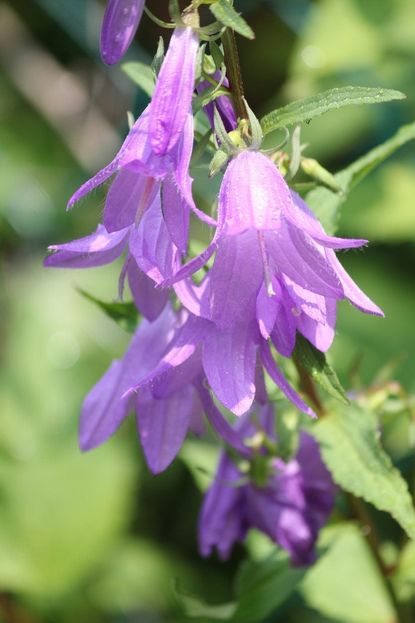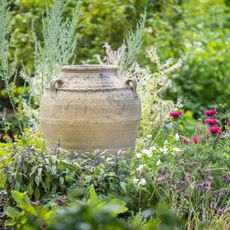What Is Creeping Bellflower & Tips On Removing Creeping Bellflower In Gardens
Pretty creeping bellflower is in disguise as a lovely little plant with purple blooms, but it's actually a burly thug that can create havoc in the garden.


Exactly what is the problem with creeping bellflower in gardens (Campanula rapunculoides in botanical parlance). Unlike its tamer Campanula garden cousin, this plant can create absolute havoc for unsuspecting gardeners.
If it’s too late and this invader has already taken over your landscape, read on to learn about removing creeping bellflowers.
What is Creeping Bellflower?
It’s said that the Old World fairytale character Rapunzel got her name from creeping bellflower after her father stole a plant from a witch’s magic garden. The witch gets revenge on the father by hiding Rapunzel away in a tower. The plant was trouble then, and it’s trouble now for anyone who gets it in their garden.
Creeping bellflower is a perennial that thrives in moist soil but tolerates nearly any soil and either sun or shade. The plant is easily identified by its heart-shaped leaves and stalks of drooping, bell-shaped blooms of lavender-blue.
It sounds innocent, but an extensive root system turns any attempt at creeping bellflower eradication into a major challenge.
If that’s not enough, creeping bellflower also regenerates by seed. In fact, the plants spread by sending down roots into every nook and cranny of the garden, including secluded shady spots, and produce between 3,000 and 15,000 seeds every year. It’s easy to see how this invasive week can quickly get out of control.
How to Get Rid of Creeping Bellflower
Eradicate creeping bellflower without using toxic chemicals. A sturdy shovel is your best weapon. Dig the plant out, but be sure to dig at least 6 to 8 inches (15-20 cm.) deep and several inches (7.5 cm) around the plant. If you leave any tiny chunks of the tuber-like roots, the plant will regrow.
Gardening tips, videos, info and more delivered right to your inbox!
Sign up for the Gardening Know How newsletter today and receive a free download of our most popular eBook "How to Grow Delicious Tomatoes."
You may be able to get the upper hand by smothering the plant, which is generally possible only if creeping bellflower is limited to small patches. Cover the patch with several layers of newspaper, then top the paper with a generous layer of soil and mulch. Deprived of light, the plant will eventually die.
Pulling is generally ineffective, although you may prevent reseeding. You may get the shallow, thread-like roots, but the plant will quickly rebound and send out new growth from the deeper roots. Mow or deadhead creeping bellflower consistently to prevent reseeding.
If all else fails, creeping bellflower in gardens may warrant careful application of an organic herbicide, but consult your local university extension service for advice on the best environmentally friendly way to eradicate this plant.

A Credentialed Garden Writer, Mary H. Dyer was with Gardening Know How in the very beginning, publishing articles as early as 2007.
-
 Front Yard Herb Garden Ideas To Spice Up Your Landscape
Front Yard Herb Garden Ideas To Spice Up Your LandscapeUse your imagination and plant a lovely front yard herb garden. You’ll love the convenience, the fragrance and the beauty, and pollinators will appreciate it.
By Amy Grant
-
 When To Clean Up Garden Beds In Spring To Protect Pollinators
When To Clean Up Garden Beds In Spring To Protect PollinatorsEvery spring, I'm reminded that many species of insects have used my garden as a winter hotel and may not be ready for a wake-up call just yet.
By Teo Spengler
-
 Serbian Bellflower Care: Tips On Growing Serbian Bellflowers
Serbian Bellflower Care: Tips On Growing Serbian BellflowersSerbian bellflower plants are a great way to add long-lasting color to the home landscape. Serbian bellflower care is minimal and you'll find it is one of the easiest plants to grow. Read this article for more info.
By Becca Badgett
-
 Campanula Care: How To Grow A Bellflower Plant
Campanula Care: How To Grow A Bellflower PlantThe lovely campanula flower, or bellflower, comes in different colors, shapes and sizes, and adds a bright, delicate element to a yard, garden or planter.
By Bonnie L. Grant
-
 Campanula Propagation - How To Plant Campanula Seed
Campanula Propagation - How To Plant Campanula SeedSince most are biennial, propagating campanula plants is often required in order to enjoy their blooms each year. Although they self-seed in some areas, this article will explain other methods of campanula propagation.
By Nikki Tilley